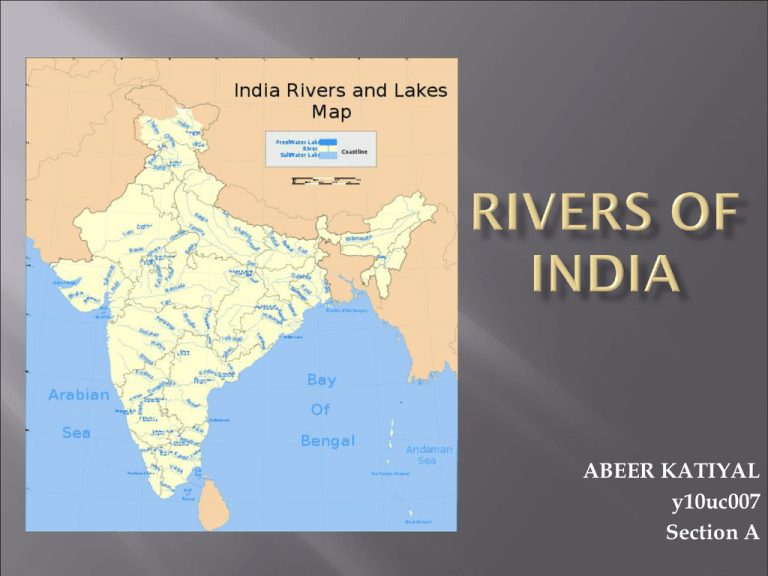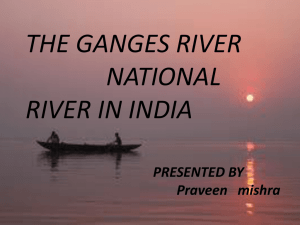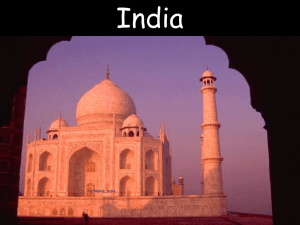Abeer-07 (1)
advertisement

ABEER KATIYAL y10uc007 Section A The rivers of India play an important role in the lives of the Indian people. The river systems provide irrigation, potable water, cheap transportation, electricity, and the livelihoods for a large number of people all over the country. This easily explains why nearly all the major cities of India are located by the banks of rivers. The rivers also have an important role in Hindu mythology and are considered holy by all Hindus in the country. Seven major rivers along with their numerous tributaries make up the river system of India. Most of the rivers pour their waters into the Bay of Bengal; however, some of the rivers whose courses take them through the western part of the country and towards the east of the state of Himachal Pradesh empty into the Arabian Sea. Parts of Ladakh, northern parts of the Aravalli range and the arid parts of the Thar Desert have inland drainage. All major rivers of India originate from one of the three main watersheds: 1. The Himalaya and the Karakoram ranges 2. Vindhya and Satpura ranges and Chotanagpur plateau in central India 3. Sahyadri or Western Ghats in western India Rivers of India India is sometimes referred to as the "Land of Rivers". The multitude of tributaries and the close binding of Indian civilization and culture to the local rivers is the reason for this characterization. Travel anywhere in India and one is overcome by how much the rivers influence the economy and local cultures. Indeed, Indians have worshipped rivers as a form of Mother Goddess from ancient times. Indus River System The Indus River originates in the northern slopes of the Kailash range near Lake Mansarovar in Tibet. Although most of the river's course runs through neighboring Pakistan, a portion of it does run through Indian territory, as do parts of the courses of its five major tributaries, listed below. These tributaries are the source of the name of the Punjab region of South Asia; the name is derived from the Persian words Punj ("five") and aab ("water"), hence the combination of the words (Punjab) means "five waters" or "land of five waters". 1. Beas The Beas originates in Beas Kund, lying near the Rohtang pass. It runs past Manali and Kulu, where its beautiful valley is known as the Kulu valley. It joins the Sutlej river near Harika, after being joined by a few tributaries. The total length of the river is 615 . 2. Chenab The Chenab originates from the confluence of two rivers, the Chandra and the Bhaga, It is also known as the Chandrabhaga in Himachal Pradesh. It runs parallel to the Pir It enters the plains of Punjab near Akhnur and is later joined by the Jhelum. It is further joined by the Ravi and the Sutlej in Pakistan. 3. Jhelum The Jhelum originates in the south-eastern part of Kashmir, in a spring at Verinag situated at the foot of the Pir Panjal in the southeastern part of the valley of Kashmir in India. It flows through Srinagar and the Wular lake before entering Pakistan through a deep narrow gorge. 4. Ravi The Ravi originates near the Rotang pass in the Himalayas and follows a north-westerly course. It turns to the south-west, near Dalhousie, and then cuts a gorge in the Dhaola Dhar range entering the Punjab plain near Madhopur. It flows as a part of the IndoPakistan border for some distance before entering Pakistan and joining the Chenab river. 5. Sutlej The Sutlej originates from the Rakas Lake, which is connected to the Manasarovar lake by a stream, in Tibet. It enters Pakistan near Sulemanki, and is later joined by the Chenab. It has a total length of almost 1500 km. The Ganges The Ganges (pronounced Hindi: गंगा Gaṅgā, as in most Indian languages) is one of the major rivers of the Indian subcontinent, flowing east through the Gangetic Plain of northern India into Bangladesh. The 2,510 km (1,560 mi) river rises in the western Himalayas in the Uttarakhand state of India, and drains into the Sunderbans delta in the Bay of Bengal. It has long been considered a holy river by Hindus and worshiped as the goddess Ganga in Hinduism. It has also been important historically: many former provincial or imperial capitals (such as Patliputra, Kannauj, Kara, Allahabad, Murshidabad, and Calcutta) have been located on its banks. The Ganges Basin drains 1,000,000-square-kilometre (390,000 sq mi) and supports one of the world's highest density of humans. The average depth of the river is 52 feet (16 m), and the maximum depth, 100 feet (30 m). Although many small streams comprise the headwaters of the Ganges, the six longest headstreams and their five confluences are given both cultural and geographical emphasis (see the map showing the headwaters of the river). The Alaknanda river meets the Dhauliganga river at Vishnuprayag, the Nandakini river at Nandprayag, the Pindar river at Karnaprayag, the Mandakini river at Rudraprayag and finally the Bhagirathi river at Devprayag, to form the mainstem, the Ganges. The Bhagirathi is the source stream; it rises at the foot of Gangotri Glacier at Gaumukh, at an elevation of 3,892 m (12,770 ft). The headwaters of the Alaknanda are formed by snowmelt from such peaks as Nanda Devi, Trisul, and Kamet. After flowing 200 km through its narrow Himalayan valley, the Ganges debouches on the Gangetic Plain at the pilgrimage town of Haridwar. There, a dam diverts some of its waters into the Ganges Canal, which irrigates the Doab region of Uttar Pradesh. The Ganges, whose course has been roughly southwestern until this point, now begins to flow southeast through the plains of northern India. Further, the river follows an 800 km curving course passing through the city of Kanpur before being joined from the southwest by the Yamuna at Allahabad This point is known as the Sangam at Allahabad. Sangam is a sacred place in Hinduism. According to ancient Hindu texts, at one time a third river, the Sarasvati, met the other two rivers at this point. Joined by numerous rivers such as the Kosi, Son, Gandaki and Ghaghra, the Ganges forms a formidable current in the stretch between Allahabad and Malda in West Bengal. On its way it passes the towns of Kanpur, Soron, Kannauj, Allahabad, Varanasi, Patna,Ghazipur,Bhagalpur,Mirzapur,Ballia, Buxar , Saidpur, and Chunar.At Bhagalpur, the river meanders past the Rajmahal Hills, and begins to run south. At Pakur, the river begins its attrition with the branching away of its first distributary, the BhāgirathiHooghly which goes on to form the Hooghly River. Near the border with Bangladesh the Farakka Barrage, built in 1974, controls the flow of the Ganges, diverting some of the water into a feeder canal linking the Hooghly to keep it relatively silt-free. river system. After entering Bangladesh, the main branch of the Ganges is known as the Padma River until it is joined by the Jamuna River, the largest distributary of the Brahmaputra. Further downstream, the Ganges is fed by the Meghna River, the second largest tributary of the Brahmaputra, and takes on the Meghna's name as it enters the Meghna Estuary. Fanning out into the 350 km wide Ganges Delta, it finally empties into the Bay of Bengal. Only two rivers, the Amazon and the Congo, have greater discharge than the combined flow of the Ganges, the Brahmaputra and the Surma-Meghna. There are two major dams on the Ganges. One at Haridwar diverts much of the Himalayan snow-melt into the Upper Ganges Canal, built by the British in 1854 to irrigate the surrounding land. This caused severe deterioration to the water flow in the Ganges, and is a major cause for the decay of Ganges as an inland waterway. The other dam is a serious hydroelectric affair at Farakka, close to the point where the main flow of the river enters Bangladesh, and the tributary Hooghly (also known as Bhagirathi) continues in West Bengal past Calcutta. This barrage, which feeds the Hooghly branch of the river by a 26 mile long feeder canal, and its water flow management has been a longlingering source of dispute with Bangladesh, A branch of the Hooghly, the Damodar, flows south and enters the Bay of Bengal at the growing port of Haldia. It has the large hydroelectric dam called Damodar Valley Project, built on the lines of the Tennessee Valley Authority. There is also a controversial dam at Tehri, on the Bhagirathi, one of the main source rivers of Ganges. Another dam is proposed to be built on the upper reaches of a tributary of the Ganges, Mahakali, This Indo-Nepal project, the Pancheswar dam, proposes to be the highest dam in the world and will be built with US collaboration. The upper and lower Ganga canal, which is actually the backbone of a network of canals, runs from Haridwar to Allahabad, but maintenance has not been very good. Tehri Dam is also constructed on Bhagirathi river, tributory of ganga. Main purpose was to supply water to New Delhi. The Ganges Basin with its fertile soil is instrumental to the agricultural economies of India and Bangladesh. The Ganges and its tributaries provide a perennial source of irrigation to a large area. Chief crops cultivated in the area include rice, sugarcane, lentils, oil seeds, potatoes, and wheat. Along the banks of the river, the presence of swamps and lakes provide a rich growing area for crops such as legumes, chillies, mustard, sesame, sugarcane, and jute. There are also many fishing opportunities to many along the river, though it remains highly polluted. Tourism is another related activity. Three towns holy to Hinduism – Haridwar, Allahabad, and Varanasi – attract thousands of pilgrims to its waters. Thousands of Hindu pilgrims arrive at these three towns to take a dip in the Ganges, which is believed to cleanse oneself of sins and help attain salvation. The rapids of the Ganges also are popular for river rafting, attracting hundreds of adventure seekers in the summer months. Muslims from India & Bangladesh often do wudu, a religious cleansing of the body for prayer in the Ganges River. The Brahmaputra The Brahmaputra,[also called Tsangpo-Brahmaputra, is a trans-boundary river and one of the major rivers of Asia. From its origin in southwestern Tibet as the Yarlung Zangbo River, it flows across southern Tibet to break through the Himalayas in great gorges and into Arunachal Pradesh where it is known as Dihang. It flows southwest through the Assam Valley as Brahmaputra and south through Bangladesh as the Jamuna (not to be mistaken with Yamuna of India). There it merges with the Ganges to form a vast delta. About 1,800 miles (2,900 km) long, the river is an important source for irrigation and transportation. Its upper course was long unknown, and its identity with the Yarlung Tsangpo was only established by exploration in 1884-86. This river is often called Tsangpo-Brahmaputra river. The average depth of river is 124 feet (38 m) and maximum depth is 380 feet (120 m). In Bangladesh the river merges with the Ganges and splits into two: the Padma and Meghna River. When it merges with the Ganges it forms the world's largest delta, the Sunderbans. The Sunderbans is known for tigers, crocodiles and mangroves. While most Indian and Bangladeshi rivers bear female names, this river has a rare male name, as it means "son of Brahma" in Sanskrit (putra means "son"). The Brahmaputra is navigable for most of its length. The lower part reaches are sacred to Hindus. The river is prone to catastrophic flooding in spring when the Himalayan snows melt. It is also one of the few rivers in the world that exhibit a tidal bore. River course The Yarlung Tsangpo originates in the Jima Yangzong glacier near Mount Kailash in the northern Himalayas. It then flows east for about 1,700 kilometres (1,100 mi), at an average height of 4,000 metres (13,000 ft), and is thus the highest of the major rivers in the world. At its easternmost point, it bends around Mt. Namcha Barwa, and forms the Yarlung Tsangpo Canyon which is considered the deepest in the world. Until Indian independence in 1947, the Brahmaputra was used as a major waterway. In the 1990s, the stretch between Sadiya and Dhubri in India was declared as National Waterway No.2., and it provides facilities for goods transportation. Recent years have seen a modest spurt in the growth of river cruises with the introduction of the cruise ship, "Charaidew," by Assam Bengal Navigation As the river enters Arunachal Pradesh, it is called Siang and makes a very rapid descent from its original height in Tibet, and finally appears in the plains, where it is called Dihang. It flows for about 35 kilometres (22 mi) and is joined by two other major rivers: Dibang and Lohit. From this point of confluence, the river becomes very wide and is called Brahmaputra. It is joined in Sonitpur District by the Jia Bhoreli (named the Kameng River where it flows from Arunachal Pradesh) and flows through the entire state of Assam. In Assam the river is sometimes as wide as 10 kilometres (6.2 mi). Between Dibrugarh and Lakhimpur districts the river divides into two channels---the northern Kherkutia channel and the southern Brahmaputra channel. The two channels join again about 100 kilometres (62 mi) downstream forming the Majuli island. At Guwahati near the ancient pilgrimage center of Hajo, the Brahmaputra cuts through the rocks of the Shillong Plateau, and is at its narrowest at 1 kilometre (1,100 yd) bank-to-bank. Because the Brahmaputra is the narrowest at this point the Battle of Saraighat was fought here. The first rail-cum-road bridge across the Brahmaputra was opened to traffic in April 1962 at Saraighat. The Sutlej The Sutlej River is the longest of the five rivers that flow through the historic crossroad region of Punjab in northern India and Pakistan. It is located north of the Vindhya Range south of the Hindu Kush segment of the Himalayas, and east of the Central Sulaiman Range in Pakistan. The Sutlej is sometimes known as the Red River. It is the easternmost tributary of the Indus River Its source is at Lake Rakshastal in Tibet near Mount Kailas, and it flows generally west and southwest entering India through the Shipki La pass in Himachal Pradesh. It waters the ancient and historically important region of Greater Punjab. The region to its south and east is arid, and is known as the Great Indian Desert or Thar Desert. The Sutlej Valley from Rampur ca. 1857 The Sutlej joins with the Beas River in Hari-Ke-Patan, Amritsar, Punjāb, India, and continues southwest into Pakistan to unite with the Chenab River, forming the Panjnad River south of ancient Multān. The Panjnad joins the Indus River at Mithankot. Indus then flows through a gorge near Sukkur, flows through the fertile plains region of Sindh, and terminates in the Arabian Sea near the port city of Karachi in Pakistan. The waters of the Sutlej are allocated to India under the Indus Waters Treaty between India and Pakistan, and are mostly diverted to irrigation canals in India. A huge, multipurpose Bhakra-Nangal Dam has been built on the Sutlej by the Indian government. There are several major hydroelectric projects on the Sutlej, e.g. the 1000MW Karcham-Wangtoo HEP. There has been a proposal to build a 214-kilometre (133 mi) long heavy freight canal, known as the Sutlej-Yamuna Link (SYL), in India to connect the Sutlej and Yamuna rivers. However, the proposal met obstacles and was referred to the Supreme Court. The Sutlej was known as Śutudri in the Vedic . The Sutlej, along with all of the Punjab rivers, is thought to have drained east into the Ganges prior to 5 mya. There is substantial geologic evidence to indicate that prior to 1700 BC at the latest, Sutlej was an important tributary of the Ghaggar-Hakra River (possibly through the Saraswati river) rather than the Indus with various authors putting the redirection from 2500-2000 BC or 5000-3000 BC. Geologists believe that tectonic activity created elevation changes which redirected the flow of Sutlej from the southeast to the southwest. The mighty Saraswati then began to dry up, causing desertification of Cholistan and the eastern part of the modern state of Sindh. The desertification resulted in abandonment of numerous ancient human settlements along the banks of Saraswati[ There is some evidence that the high rate of erosion caused by the modern Sutlej River has influenced the local faulting and rapidly exhumed rocks above Rampur. This would be similar to, but on a much smaller scale then, the exhumation of rocks by the Indus River in Nanga Parbat, Pakistan. The Sutlej river also exposes a doubled inverted metamorphic gradient The source of the Sutlej is just west of Mt. Kailash in western Tibet. This is roadless area, and was first explored by kayak and raft by Russian and German teams in 2004. The largest modern industrial city along the Sutlej banks is Ludhiana. The Yamuna The Yamuna is the largest tributary river of the Ganges (Ganga) in northern India. Originating from the Yamunotri Glacier at a height 6,387 mtrs., on the south western slopes of Banderpooch peaks, in the Lower Himalayas, it travels a total length of 1,376 kilometers (855 mi) and has a drainage system of 366,223 km2, 40.2% of the entire Ganga Basin, before merging with the Ganges at Triveni Sangam, Allahabad, the site for the Kumbha Mela every twelve years. It crosses several states, Uttarakhand, Haryana and Uttar Pradesh, passing by Himachal Pradesh and later Delhi, and meets several of its tributaries on the way, including Tons, its largest and longest tributary, Chambal, which has its own large basin, followed by Sindh, the Betwa, and Ken. Most importantly it creates the highly fertile alluvial, 'Yamuna-Ganga Doab' region between itself and the Ganges in the Indo-Gangetic plain. Nearly 57 million people depend on the Yamuna waters. With an annual flow of about 10,000 cubic metres (cum) and usage of 4,400 cum (of which irrigation constitutes 96 per cent), the river accounts for more than 70 per cent of Delhi’s water supplies. Just like the Ganges, the Yamuna too is highly venerated in Hinduism and worshipped as goddess Yamuna, throughout its course. In Hindu mythology, she is the daughter of Sun God, Surya, and sister of Yama, the God of Death, hence also known as Yami, and according to popular legends, bathing in its sacred waters frees one from the torments of death . The water of Yamuna is of "reasonably good quality" through its length from Yamunotri in the Himalayas to Wazirabad in Delhi, about 375 km, where the discharge of waste water through 15 drains between Wazirabad barrage and Okhla barrage renders the river severely polluted after Wazirabad in Delhi. One official describes the river as a "sewage drain" with biochemical oxygen demand (BOD) values ranging from 14 to 28 mg/l and high coliform content. There are three main sources of pollution in the river, namely households and municipal disposal sites, soil erosion resulting from deforestation occurring to make way for agriculture along with resulting chemical wash-off from fertilizers, herbicides, and pesticides and run-off from commercial activity and industrial sites. The source of Yamuna lies in the Yamunotri Glacier at a height 6,387 mtrs., on the south western slopes of Banderpooch peaks, which lie in the Mussoorie range of Lower Himalayas, in the Uttarkashi district, Uttarakhand, north of Haridwar. Yamunotri temple, a shrine dedicated to the goddess, Yamuna is one of the holiest shrines in Hinduism, and part of the Chota Char Dham Yatra circuit. Also standing close to the temple, on its 13 km trek route, that follows the right bank of the river, lies the Markendeya Tirtha, where the sage Markandeya wrote the Markandeya Purana. From here it flows southwards, for about 200 km through the Lower Himalayas and the Shivalik Hills Range and morainic deposited are found in its steep Upper Yamuna valley, highlighted with geomorphic features such as interlocking spurs, steep rock benches, and stream terraces. Large terraces formed over a long period of time can be seen in the lower course of the river, like ones near Naugoan. An important part of its early catchment area totalling 2,320 km² lies in Himachal Pradesh, and an important tributary draining the Upper Catchment Area is the Tons, Yamuna's largest and longest tributary, which rises from the Hari-kidun valley and holds water more than the main stream, which it merges after Kalsi near Dehradun. The entire drainage system of the river stretches all the way between Giri-Sutlej catchment in Himachal and Yamuna-Bhilangna catchment in Garhwal, indeed the southern ridge of Shimla is also drained into this system. Other tributaries in the region are the Giri, Rishi Ganga, Kunta, Hanuman Ganga and Bata tributaries, which drain the Upper Catchment Area of the vast Yamuna basin. Thereafter the river descends on to the plains of Doon Valley, at Dak Pathar near Dehradun. Here through a weir dam, the water is diverted into a canal for power generation, little further down where Yamuna is met by the Assan River, lies the Assan barrage, which hosts a Bird Sanctuary as well. After passing the Sikh pilgrimage town of Paonta Sahib, it reaches Tajewala in Yamuna Nagar district, of Haryana, where a dam built in 1873, is the originating place of two important canals, the Western Yamuna Canal and Eastern Yamuna Canal, which irrigate the states of Haryana and Uttar Pradesh. The Western Yamuna Canal (WYC) crosses Yamuna Nagar, Karnal and Panipat before reaching the Haiderpur treatment plant, which supplies part of municipal water supply to Delhi, further it also receives waste water from Yamuna Nagar and Panipat cities. Yamuna is replenished again after this by seasonal streams and groundwater accrual, in fact during the dry season, it remains dry in many stretches from Tajewala till Delhi, where it enters near Palla village after traversing 224 km. The Yamuna also creates natural state borders between the Himachal Pradesh and Uttarakhand states, and further down between the state of Haryana and Uttar Pradesh. Along with Ganga to which run almost parallel after it touches the Indo-Gangetic plain, the largest alluvial fertile plain in the world, it creates the Ganga-Yamuna Doab region spread across 69,000 km2, one-third of the entire plain, and today known for its agricultural outputs, prominent among them is the cultivation of Basmati Rice. The plain itself supports one-third of India's population through its farming. State Catchment area (km2) Uttar Pradesh and Uttarakhand 74,208 Himachal Pradesh 5,799 Haryana 21,265 Rajasthan 102,883 Madhya Pradesh 14,023 Delhi 1,485 Subsequently, it flows through the states of Delhi, Haryana and Uttar Pradesh, before merging with the Ganges at a sacred spot known as Triveni Sangam in Allahabad after traversing a distance of 1,376 kilometers (855 miles). Here pilgrims travel by boats to platforms erected mid stream to offer prayers. During the Kumbh Mela, held every 12 years, the ghats around the Sangam are venue of large congregation of people, who take dip in the sacred waters of the confluence. The cities of Baghpat, Delhi, Noida, Mathura, Agra, Firozabad, Etawah, Kalpi, Hamirpur, Allahabad lie on its banks. At Etawah, it meets it another important tributary, Chambal, followed by a host of tributaries further down, including, Sindh, the Betwa, and Ken. Tributaries Tons River, Yamuna's largest and longest tributary, rises in the 20,720 ft (6,315 meters) high Bandarpoonch mountain, and has a large basin in Himachal Pradesh. It meets Yamuna below Kalsi near Dehradun, Uttarakhand. Hindon River, originates in the Saharanpur District, from Upper Shivalik in Lower Himalayan Range, is entirely rainfed and has a catchment area of 7, 083 km2, traverses 400 km through Muzaffarnagar District, Meerut District, Baghpat District, Ghaziabad, Noida, Greater Noida, before joining Yamuna just outside Delhi. Ken River, flows through Bundelkhand region of Madhya Pradesh and Uttar Pradesh, it originates near village Ahirgawan in Jabalpur district and travels a distance of 427 km, before merging with the Yamuna at Chilla village, near Fatehpur in Uttar Pradesh, and has an overall drainage basin of 28,058 km2. Chambal River, known as Charmanvati in ancient times, flows through Rajasthan and Madhya Pradesh, with a drainage basin of 143,219 km2 and traverses a total distance of 960 km, from its source in Vindhya Range, near Mhow and support hydro-power generation at Gandhi Sagar dam, Rana Pratap Sagar dam and Jawahar Sagar dam, before merging into the Yamuna south east of Sohan Goan, in Etawah district, shortly there after followed by another tributary, the Sindh River. Irrigation The importance of Yamuna in the Indo-Gangetic Plains is enhanced by its many canals, some dating back to as early as 14th century CE by Tughlaq dynasty, which built the Nahr-i-Bahisht (Paradise), parallel to the river, it was later restored and extended by the Mughals in the first half of seventeenth century, by engineer Ali Mardan Khan, starting from Benawas where the river enters the plains and terminating near the Mughal capital, Shahjahanabad, the present city of Delhi [21]. As the Yamuna enters the Northern plains near Dak Pathar at a height of 790 meters, two canals namely, the Eastern and Western Yamuna Canals commence from the Assan barrage about 11 kilometers from Dak Pathar in Doon Valley, the canals irrigate vast tracts of lands in the region, then once its passes Delhi, it feeds the Agra Canal built in in 1874, which starts from Okhla barrage beyond the Nizamuddin bridge, and the high land between the Khari-Nadi and the Yamuna and before joining the Banganga river about 20 miles below Agra. Thus during the summer season, the stretch above Agra resembles a minor stream. A heavy freight canal, known as the Sutlej-Yamuna Link (SYL), is being built westwards from near its headwaters through the Punjab region near an ancient caravan route and highlands pass to the navigable parts of the Sutlej-Indus watershed. This will connect the entire Ganges, which flows to the east coast of the subcontinent, with points west (via Pakistan). When completed, the SYL will allow shipping from India's east coast to the west coast and the Arabian sea, drastically shortening shipping distances and creating important commercial links for north-central India's large population. The canal starts near Palla village near Delhi, and was to transfer Haryana's share of 3.5 MAF from Indus Basin, though state of Haryana has completed its portion, Punjab is against its construction, and the state legislature passed the "Punjab Termination of Agreement Act 2004", which declared earlier agreements null and void. Geography and wildlife The catchment area of the river, especially till its touches the plains, is replete with Alpine, semi alpine, temperate and sub-tropical vegetation, and vast areas are under forest over, and supports extensive animal life. Yamuna is the frontier of the Asian Elephant. West of the Yamuna, there are no elephants to be found over 900 km of the western Himalayas and their foothills. The forests of the lower Yamuna offer ideal corridors for elephant movement. The principal forests to be found here are of sal , khair (acacia) , and sissoo (rosewood) trees, and the Chir Pine forests of the Shivalik Hills. The Narmada The Narmada is a river in central India and the fifth largest river in the Indian subcontinent. Narmada is a Sanskrit word meaning 'the Giver of Pleasure'[3]. It forms the traditional boundary between North India and South India and flows westwards over a length of 1,312 km (815.2 mi) before draining through the Gulf of Cambey (Khambat) into the Arabian Sea, 30 km (18.6 mi) west of Bharuch city of Gujarat. It is one of only three major rivers in pensinsular India that runs from east to west (largest west flowing river) along with the Tapti River and the Mahi River. It is the only river in India that flows in a rift valley flowing west between the Satpura and Vindhya ranges although the Tapti River and Mahi River also flow through rift valleys but between different ranges. It flows through the states of Madhya Pradesh (1,077 km (669.2 mi)), Maharashtra, (74 km (46.0 mi))– (35 km (21.7 mi)) border between Madhya Pradesh and Maharashtra and (39 km (24.2 mi) border between Madhya Pradesh and Gujarat and in Gujarat (161 km (100.0 mi)). The source of the Narmada is a small tank called Narmada Kund located on the Amarkantak hill (1,057 m (3,467.8 ft)), in the Shahdol District of eastern Madhya Pradesh. The river descends from the Amarkantak hill range at the Kapildhara falls over a cliff and meanders in the hills flowing through a tortuous course crossing the rocks and islands up to the ruined palace of Ramnagar. Between Ramnagar and Mandla, (25 km (15.5 mi)), further southeast, the course is comparatively straight with deep water devoid of rocky obstacles. The Banger joins from the left. The river then runs north–east in a narrow loop towards Jabalpur. Close to this city, after a fall of some (9 m (29.5 ft)), called the Dhuandhara, the fall of mist, it flows for (3 km (1.9 mi)), in a deep narrow channel through the magnesium limestone and basalt rocks called the Marble Rocks; from a width of about 90 m (295.3 ft), above, it is compressed in this channel of (18 m (59.1 ft)), only. Beyond this point up to its meeting the Arabian Sea, the Narmada enters three narrow valleys between the Vindhya scarps in the north and the Satpura range in the South. The southern extension of the valley is wider at most places. These three valley sections are separated by the closely approaching line of the scarps and the Satpura hills. Emerging from the Marble Rocks the river enters its first fertile basin, which extends about 320 km (198.8 mi), with an average width of 35 km (21.7 mi), in the south. In the north, the valley is limited to the Barna–Bareli plain terminating at Barkhara hills opposite Hoshangabad. However, the hills again recede in the Kannod plains. The banks are about (12 m (39.4 ft)) high. It is in the first valley of the Narmada that many of its important tributaries from the south join it and bring the waters of the northern slopes of the Satpura hills. Among them are: the Sher, the Shakkar, the Dudhi, the Tawa (biggest tributary) & the Ganjal. The Hiran, the Barna, the Choral, the Karam and the Lohar are the important tributaries joining from the north. Below Handia and Nemawar to Hiran fall (the deer's leap), the river is approached by hills from both sides. In this stretch the character of the river is varied. The Omkareshwar island, sacred to the Lord Shiva, is the most important river island in Madhya Pradesh. At first, the descent is rapid and the stream, quickening in pace, rushes over a barrier of rocks. The Sikta and the Kaveri join it below the Khandwa plain. At two points, at Mandhar, about40 km (24.9 mi), below Nemawar, and Dadrai, 40 km (24.9 mi), further down near Punasa, the river falls over a height of about 12 m (39.4 ft). A few kilometres further down near Bareli and the crossing ghat of the Agra to Mumbai road, National Highway No 3, the Narmada enters the Mandleshwar plain, the second basin about 180 km (111.8 mi) long and 65 km (40.4 mi) wide in the south. The northern strip of the basin is only 25 km (15.5 mi). The second valley section is broken only by Saheshwar Dhara fall. The early course of about 125 km (77.7 mi) up to Markari falls is met with a succession of cataracts and rapids from the elevated table land of Malwa to the low level of Gujarat plain. Towards the west of this basin, the hills draw very close but soon dwindle down. Below Makrai, the river flows between Vadodara district and Narmada district and then meanders through the rich plain of Bharuch district of Gujarat state. The banks are high between the layers of old alluvial deposits, hardened mud, gravels of nodular limestone and sand. The width of the river spans from about 1.5 km (0.9 mi) at Makrai to 3 km (1.9 mi) near Bharuch and to an estuary of 21 km (13.0 mi) at the Gulf of Khambat. An old channel of the river, 1 km (0.6 mi) to 2 km (1.2 mi) south from the present one, is very clear below Bharuch. The Karanjan and the Orsing are the most important tributaries in the original course. The former joins at Rundh and the latter at Vyas in Vadodara district of Gujarat, opposite each other and form a Triveni (confluence of three rivers) on the Narmada. The Amaravati and the Bhukhi are other tributaries of significance. Opposite the mouth of the Bhukhi is a large drift called Alia Bet or Kadaria Bet. The tidal rise is felt up to 32 km (19.9 mi) above Bharuch, where the neap tides rise to about a metre and spring tide 3.5 m (11.5 ft). The river is navigable for vessels of the burthen of 95 tonnes (i.e., 380 Bombay candies) up to Bharuch and for vessels up to 35 tonnes (140 Bombay candies) up to Shamlapitha or Ghangdia. The small vessels (10 tonnes) voyage up to Tilakawada in Gujarat. There are sand bases and shoals at mouth and at Bharuch. The nearby island of Kabirvad, in the Narmada River, features a gigantic Banyan tree, which covers 10,000 square metres (2.5 acres). Narmada basin The Narmada basin, hemmed between Vindya and Satpuda ranges, extends over an area of 98,796 km2 (38,145.3 sq mi) and lies between east longitudes 72 degrees 32' to 81 degrees 45' and north latitudes 21 degrees 20' to 23 degrees 45' lying on the northern extremity of the Deccan Plateau. The basin covers large areas in the states of Madhya Pradesh (86%), Gujarat (14%) and a comparatively smaller area (2%) in Maharashtra. In the river course of 1,312 km (815.2 mi) explained above, there are 41 triburaries, out of which 22 are from the Satpuda range and the rest on the right bank are from the Vindhya range. The basin has five well defined physiographic regions. They are:(1) The upper hilly areas covering the districts of Shahdol, Mandla, Durg, Balaghat and Seoni, (2) The upper plains covering the districts of Jabalpur, Narsimhapur, Sagar, Damoh, Chhindwara, Hoshangabad, Betul, Raisen and Sehore, (3) The middle plains covering the districts of East Nimar, part of west Nimar, Dewas, Indore and Dhar, (4) The lower hilly areas covering part of the west Nimar, Jhabua, Dhulia, Narmada and parts of Vadodara, and (5) the lower plains covering mainly the districts of Narmada Bharuch, and parts of Vadodara. The hill regions are well forested. The upper, middle and lower plains are broad and fertile areas, well suited for cultivation. The Narmada basin mainly consists of black soils. The coastal plains in Gujarat are composed of alluvial clays with a layer of black soils on the surface. The valley experiences extremes of hydrometeorological and climatic conditions with the upper catchment having an annual precipitation in the range of1,000 mm (3.3 ft) to 1,850 mm (6.1 ft) and with half or even less than half in its lower regions (650 mm (2.1 ft)–750 mm (2.5 ft)); the diversity of vegetation from lushgreen in the upper region to dry deciduous teak forest vegetation in the lower region is testimony to this feature. The Irrigation Commission (1972) identified the Narmada basin in Madhya Pradesh as drought affected and a large part of North Gujarat, Saurashtra and Kutch as semiarid or arid scarcity regions on account of extreme unreliability of rainfall, rendering them ‘chronically’ drought prone and subject to serious drinking water problems.








